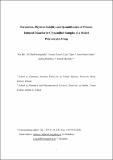Formation, physical stability, and quantification of process-induced disorder in cryomilled samples of a model polymorphic drug
Date
2012-10-09Author
Hu, Yun
MacFhionnghaile, Pól
Caron, Vincent
Tajber, Lidia
Healy, Anne Marie
Erxleben, Andrea
McArdle, Patrick
Metadata
Show full item recordUsage
This item's downloads: 296 (view details)
Cited 18 times in Scopus (view citations)
Recommended Citation
Hu, Yun, Macfhionnghaile, Pól, Caron, Vincent, Tajber, Lidia, Healy, Anne Marie, Erxleben, Andrea, & McArdle, Patrick. Formation, Physical Stability, and Quantification of Process-Induced Disorder in Cryomilled Samples of a Model Polymorphic Drug. Journal of Pharmaceutical Sciences, 102(1), 93-103. doi: 10.1002/jps.23338
Published Version
Abstract
The formation and physical stability of amorphous sulfathiazole obtained from polymorphic forms I and III by cryomilling was investigated by X-ray powder diffraction (XRPD) and near-infrared (NIR) spectroscopy. Principal component analysis was applied to the NIR data to monitor the generation of crystalline disorder with milling time and to study subsequent recrystallization under different storage conditions. Complete conversion into the amorphous phase was observed for both forms after 45 (form I) and 150 min (form III) milling time. Upon storage under vacuum over silica gel for 14 days at 4 degrees C, amorphous samples remained amorphous. However, under the same conditions at ambient temperature, recrystallization occurred. Amorphous samples obtained from form I had crystallized back to the original polymorph, whereas those prepared from form III had partially crystallized to mixtures of polymorphs. Amorphous samples stored at ambient temperature and humidity absorbed moisture, which facilitated crystallization to a mixture of polymorphs in both cases. Quantitative analyses of amorphous content in binary mixtures with forms I and III were carried out by XRPD and NIR spectroscopy combined with partial least squares regression. The calibration models had root mean square error of prediction values of


